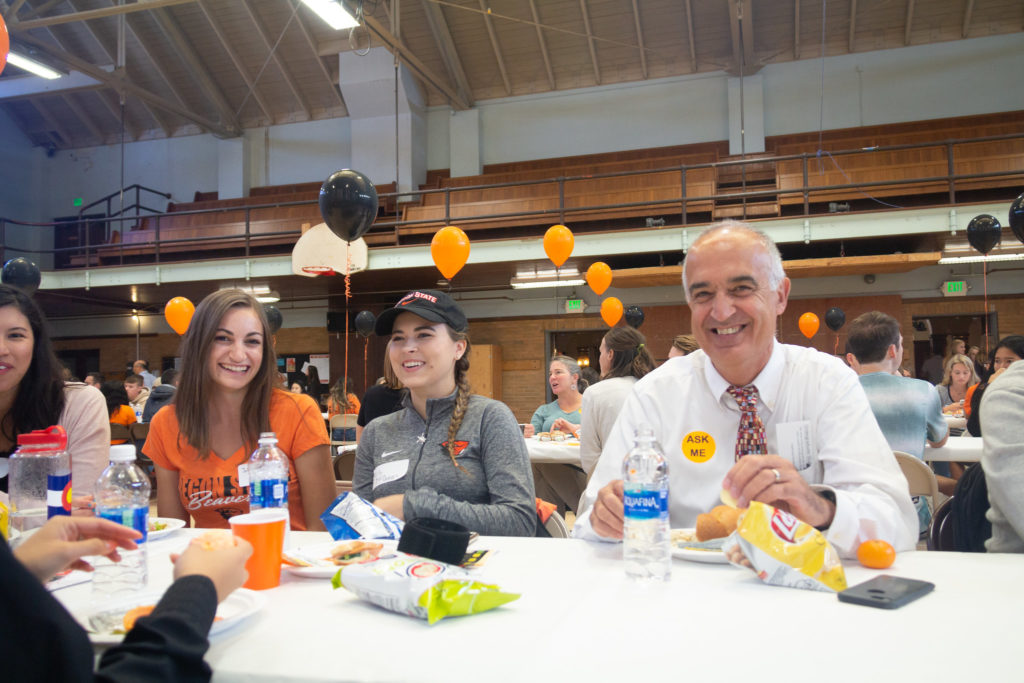Spotlight: “Strategic Plan Q and A” with F. Javier Nieto, MD, PhD, MPH and Dean of Oregon State University College of Public Health and Human Sciences
We talked with Dean Nieto about his vision and strategic planning exercise for Oregon State’s College of Health and Human Sciences and the result: Health and Well-Being for All: A five-year strategic plan, 2018-2023.
Why was strategic planning a timely exercise for the College of Public Health and Human Sciences?
I felt it was something we needed to do because the college was at a crossroads, with a changing environment internally and externally. The college itself was relatively new following a merger of other units and growing very rapidly, with myself as the new dean. We also had a new university provost, new university funding realities and newly emerging priorities for public health regionally and globally.
I’d been a skeptic of strategic planning before arriving at Oregon State, but this was the right thing to do in this particular time to clarify and align around our direction as a college.
How does the strategic plan better align the college with the university’s direction?
It achieves alignment in two chief ways. One, the university’s new way to distribute funding to the units, based on a “responsibility-centered management”-type meant that the college would have to find ways to be more efficient and strategic to generate revenue and support its programs. The greater opportunity, however, was the simultaneous development of our college plan and the university’s next strategic plan and defining our role in Oregon State’s Vision 2030. One of its pillars is “Leading in Health and Wellness.” Our consultants interviewed university leaders to gain their perspectives, and we involved a variety of university leaders on our strategic planning committees, Thought Leadership Forum and stakeholder engagement activities.
The outcome of our discussions clearly positions the college as an anchor and facilitator of the university’s long-term vision for contributing to health and wellness locally and globally. The “overarching goal” framing our strategic plan describes our leadership advantage: “Champion the discovery and implementation of ideas that advance the lifelong wellness of people and communities as part of OSU’s integrated health sciences initiative.”
How will the College of Public Health and Human Sciences differentiate itself and raise its visibility through the new strategic plan?
We have identified several priorities. As a College of Public Health and Human Sciences that is not affiliated with a medical school, we have the unique advantage of grounding our work in true health and disease prevention in communities. We explicitly recognize that to be successful in our mission we need to and want to work with the other colleges at OSU in an integrated fashion (science, business, engineering, liberal arts, veterinary medicine, pharmacy, etc.), all which have components related to public health. Additionally, the college is committed to a lifespan perspective that embraces an integrated approach to health.
Second, we must become more proactive in engaging and recruiting students, not only in response to the needs of our communities but also because the university’s new budget model is tied to our enrollments, retention and graduation rates. In other words, we must become better at marketing ourselves and our distinct lens on public health and wellness, and on ensuring student success in the college and in their careers following graduation.
Third, I was attracted to OSU because its strong commitment to the land-grant mission of the university and because we have health Extension programs in the college. To leverage the full value of Extension’s connections to our communities, we are making explicit and sustained efforts to integrate Extension into everything we do. In many respects, the healthy outcomes of our communities depend on the applied work of our Extension faculty in communities, so collaboration among faculty across the college is vital.
How will you measure the plan’s impact?
Ultimately through changing lives in our communities as part of OSU’s integrated health sciences initiative, and, in the short term, by determining and demonstrating where our programs are making a difference. As one example, our mental health initiative, which we launched in parallel with the strategic planning process and whose objectives are built in, is already having an impact in our communities. Like other signature activities, it is tied to our fundraising story—with higher levels of private support this year, we were able to invest in the mental health initiative. This could not have happened without greater strategic focus on change-making expertise within the college.
As you mentioned earlier, there is frequently resistance in academe to strategic planning. What is your view of the process itself?
I cannot think of anything we would have done differently other than finish sooner, which largely was related to academic year scheduling. This was an incredibly useful exercise for me as the dean, to learn a lot about the culture of the institution and give our people the opportunity to engage in the process. There seems to be a general sense that this was a good process and a good way to generate buy-in for the plan. The Thought Leadership Forum, where our faculty engaged in provocative dialogue with other national experts and each other, was a tremendously successful, helpful, and energizing way to launch the strategic planning process.
About Dean Javier Nieto
Dr. Nieto is a physician-epidemiologist and expert in epidemiology research and teaching. He joined Oregon State University in Fall 2016 to become professor and dean of the College of Public Health and Human Sciences. Trained as an MD in Valencia, Spain, he earned subsequent degrees in Havana, Cuba and at Johns Hopkins University. In 2002, he became the inaugural Helfaer Professor of Public Health and chair of the Department of Population Health Sciences at University of Wisconsin-Madison. He is the author or co-author of more than 250 peer-reviewed papers and book chapters and co-author of Epidemiology Beyond the Basics, a textbook widely used in graduate programs worldwide.

